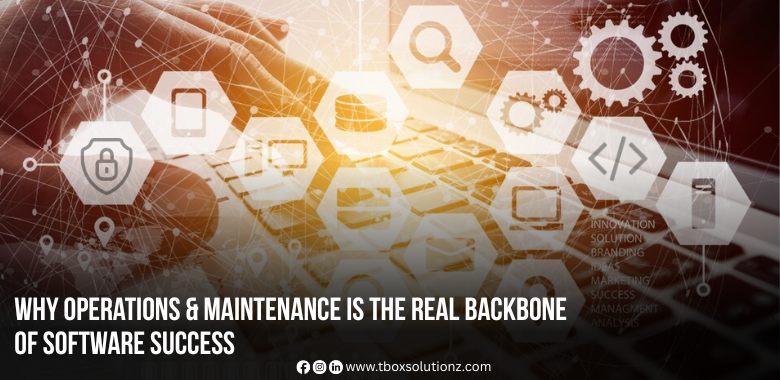In the world of software services, the emphasis is often placed on development and deployment. But in reality, a software product’s lifecycle doesn’t peak at launch; it begins there. Operations and Maintenance (O&M) represent the backbone of sustainable software performance, user satisfaction, and business continuity. Ignoring O&M is not just shortsighted; it’s a liability.
What is O&M in Software?
Operations and Maintenance encompass services that keep software running effectively post-deployment. This includes bug fixes, system upgrades, security patching, performance tuning, environment adaptability, and ongoing user support. These services ensure that software doesn’t just exist; it evolves, adapts, and thrives.
Why O&M Is a Strategic Investment
O&M should be viewed not as an expense but as a strategic pillar of software success. Here’s why:
- Maximized Uptime: Proactive monitoring and quick incident response reduce costly downtime.
- Enhanced User Experience: Continuous refinement ensures software aligns with user needs and expectations.
- Stronger Security Posture: Regular patching and updates mitigate vulnerabilities.
- Compliance & Audit Readiness: Ensures alignment with evolving regulations.
- Extended Software Lifecycle: With consistent maintenance, software remains relevant and cost-effective over time.
A 2022 report from the Consortium for IT Software Quality (CISQ) found that poor software quality in the US alone cost businesses over $2.41 trillion, a significant portion of which stemmed from failures in maintenance and operational oversight. 🔗
Types of Software Maintenance
Understanding the categories of maintenance provides clarity on where investments should be made:
- Corrective: Addressing bugs and defects.
- Adaptive: Modifying software to accommodate environmental changes (OS updates, new hardware).
- Perfective: Enhancing functionality or performance based on user feedback.
- Preventive: Refactoring and optimizations to preempt future issues.
O&M in the Age of Agile and DevOps
The traditional divide between development and maintenance is collapsing. With DevOps and Agile methodologies, O&M is now integrated into continuous delivery pipelines. This includes:
- Automated Monitoring & Alerting
- Infrastructure as Code (IaC) for consistency and repeatability
- Continuous Integration/Continuous Deployment (CI/CD) for rapid, safe updates
- SRE Principles to ensure reliability at scale
Real-World Examples of O&M in Software Development
In the software development industry, the success of products heavily relies on robust O&M strategies. Consider these examples:
- Shopify: Handles rapid feature rollouts and infrastructure scaling through strong maintenance practices.
- GitLab: Continuously improves platform stability with extensive CI/CD pipelines and incident management.
- Zoom: Maintains user satisfaction and scalability with ongoing updates and security patches post-pandemic growth.
- WordPress (WooCommerce): Requires ongoing patching and plugin maintenance to avoid performance and security vulnerabilities.
- Government Platforms: Agencies such as the U.S. Department of Veterans Affairs and the UK’s GOV. UK Digital Service relies on continuous O&M support to meet regulatory requirements, apply critical security patches, and manage legacy systems with high availability for citizens and stakeholders alike.
The Cost of Ignoring O&M
Failing to invest in proper O&M introduces significant risks, especially for medium to large-scale software platforms:
- Technical Debt: Accumulated shortcuts or outdated code increase future development costs.
- Security Vulnerabilities: Unpatched systems become easy targets for exploits.
- Downtime and Instability: Lack of proactive maintenance can lead to frequent crashes or degraded performance.
- Reputational Damage: Poor maintenance can frustrate users and erode trust in your platform.
- Loss of Competitive Edge: Without regular updates and performance tuning, software becomes obsolete.
Examples of fallout:
- Revolut: In 2022, the fintech company faced service outages and degraded performance due to postponed infrastructure updates. 🔗
- WooCommerce: Thousands of online stores have been widely targeted due to unpatched plugin vulnerabilities in 2021. 🔗
- British Airways: suffered a massive IT systems outage in 2017 due to poor infrastructure maintenance, leading to flight cancellations for over 75,000 passengers, costing the airline an estimated $100 million, an enduring example of the high price of neglecting O&M. 🔗
TBox Solutionz: Your Partner for Scalable O&M
Software success is not just about building it right; it’s about keeping it right. At TBox Solutionz, we specialize in providing end-to-end O&M services aligned with business outcomes, performance goals, and compliance requirements.
Whether it’s post-launch support, cloud optimization, or continuous performance tuning, our team ensures your product stays reliable, scalable, and secure long after go-live.
Final Thoughts
In today’s software-driven economy, the real test of a digital product begins after its release. Investing in robust O&M practices is not just a best practice; it’s a business imperative.
Ready to make software longevity a priority? Let’s start with a conversation.
